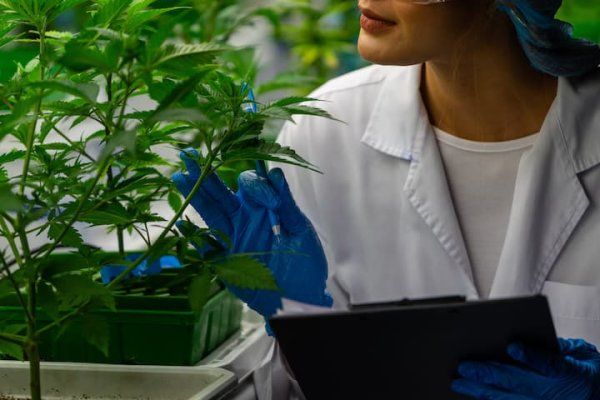A team of scientists at Leipzig University has pioneered a novel technique for creating cis-tetrahydrocannabinol (cis-THC)—a natural compound found in cannabis plants that induces the well-known psychoactive effects and has numerous potential uses, including in the pharmaceutical sector.
"The method we've developed enables the production of cis-tetrahydrocannabinoids and allows for testing their biological properties," says researcher Caroline Dorsch, who collaborated with Professor Christoph Schneider from the Institute of Organic Chemistry to publish their findings in the journal Angewandte Chemie.
Dorsch highlights the lack of a consistent method for synthesizing this class of compounds until now. The innovative, affordable, and nature-inspired synthesis from the Leipzig team has made cis-tetrahydrocannabinoids available for a wide array of applications for the first time. Their technique is considered superior to previous methods that required numerous steps and large quantities of chemicals and solvents. The new method allows for the synthesis of the compound with high overall yields and outstanding optical purities.
Tetrahydrocannabinol is one of the phytocannabinoids generated by cannabis plants, primarily accumulating in the flowers of female plants. The psychoactive properties of this compound have been known since the 1960s.
Investigations into this natural compound led to the discovery of its mode of action—the endocannabinoid system. This term refers to the signaling pathway in the body that is influenced by tetrahydrocannabinol, resulting in the typical effects of marijuana consumption.
"Targeting this pathway has pharmaceutical implications. Cannabinoids can exhibit various effects in the body, such as acting as pain relievers, antipsychotics, or anti-epileptics. However, only a few cannabinoids are currently available in the pharmaceutical market. The prescription of natural cannabis products is sometimes regarded as an exception," explains Dorsch.
In Germany, the Narcotics Act (BtMG) prohibits the possession, cultivation, and distribution of narcotic cannabis products. Samples containing trans-configured cannabinoids are classified as narcotics. Recent research indicates that cis-THC primarily accumulates in parts of the cannabis plant where the related trans-compounds are not present. This has led to the classification of such samples as textile or non-narcotic hemp. However, cis-THC does possess mild psychoactive properties.
THC is a chiral compound, meaning its atoms are arranged in a spatial configuration that cannot be superimposed on its mirror image. These compounds and their mirror images are called enantiomers and often exhibit different effects in the human body. Although nature can easily control the targeted synthesis of these compounds, achieving this under laboratory conditions presents a significant challenge—successfully overcome in this study.
The newly developed technique also requires minimal catalyst amounts, making it environmentally friendly by conserving energy and resources and reducing by-products.
cis-THC has been less studied than the more potent trans-THC. However, other natural compounds not derived from cannabis share a basic structure with cis-THC. These valuable compounds exhibit promising pharmacological properties that warrant further investigation.
This groundbreaking approach has established a crucial foundation for the in-depth study of this group of compounds. Using this method, researchers have produced several other natural and non-natural members of this structural class, including cis-THC.
"The method we've developed enables the production of cis-tetrahydrocannabinoids and allows for testing their biological properties," says researcher Caroline Dorsch, who collaborated with Professor Christoph Schneider from the Institute of Organic Chemistry to publish their findings in the journal Angewandte Chemie.
Dorsch highlights the lack of a consistent method for synthesizing this class of compounds until now. The innovative, affordable, and nature-inspired synthesis from the Leipzig team has made cis-tetrahydrocannabinoids available for a wide array of applications for the first time. Their technique is considered superior to previous methods that required numerous steps and large quantities of chemicals and solvents. The new method allows for the synthesis of the compound with high overall yields and outstanding optical purities.
Tetrahydrocannabinol is one of the phytocannabinoids generated by cannabis plants, primarily accumulating in the flowers of female plants. The psychoactive properties of this compound have been known since the 1960s.
Investigations into this natural compound led to the discovery of its mode of action—the endocannabinoid system. This term refers to the signaling pathway in the body that is influenced by tetrahydrocannabinol, resulting in the typical effects of marijuana consumption.
"Targeting this pathway has pharmaceutical implications. Cannabinoids can exhibit various effects in the body, such as acting as pain relievers, antipsychotics, or anti-epileptics. However, only a few cannabinoids are currently available in the pharmaceutical market. The prescription of natural cannabis products is sometimes regarded as an exception," explains Dorsch.
In Germany, the Narcotics Act (BtMG) prohibits the possession, cultivation, and distribution of narcotic cannabis products. Samples containing trans-configured cannabinoids are classified as narcotics. Recent research indicates that cis-THC primarily accumulates in parts of the cannabis plant where the related trans-compounds are not present. This has led to the classification of such samples as textile or non-narcotic hemp. However, cis-THC does possess mild psychoactive properties.
THC is a chiral compound, meaning its atoms are arranged in a spatial configuration that cannot be superimposed on its mirror image. These compounds and their mirror images are called enantiomers and often exhibit different effects in the human body. Although nature can easily control the targeted synthesis of these compounds, achieving this under laboratory conditions presents a significant challenge—successfully overcome in this study.
The newly developed technique also requires minimal catalyst amounts, making it environmentally friendly by conserving energy and resources and reducing by-products.
cis-THC has been less studied than the more potent trans-THC. However, other natural compounds not derived from cannabis share a basic structure with cis-THC. These valuable compounds exhibit promising pharmacological properties that warrant further investigation.
This groundbreaking approach has established a crucial foundation for the in-depth study of this group of compounds. Using this method, researchers have produced several other natural and non-natural members of this structural class, including cis-THC.




